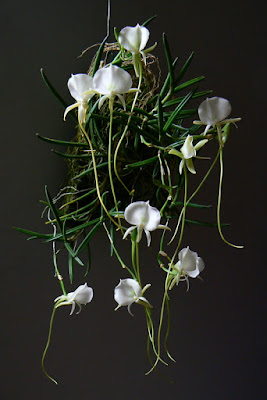Angraecum scottianum is found in the island of Comoros, where it grows epiphytic in trees in open exposed areas at an altitude of 350 to 600 meters above sea level...
Angraecum scottianum also called as Scott's Angraecum, Angorchis scottiana, Angraecum reichenbachianum, is a species of the genus Angraecum. This species was described by Heinrich Gustav Reichenbach in 1878.
IDENTIFY ANGRAECUM SCOTTIANUM ORCHID PLANT
Angraecum scottianum is found in the island of Comoros, where it grows epiphytic in trees in open exposed areas at an altitude of 350 to 600 meters above sea level.
It is a small sized, hot to warm growing epiphyte with erect or pendant, elongated, cylindrical stems carrying 6 to 8, subcylindrical or terete, subulate, bicarinate, canaliculate leaves.
Scott's Angraecum blooms in the spring, summer and early fall on a 10 cm long, axillary, slender, mostly ascending raceme with scarious bracts and carrying fragrant, inverted, waxy, successively opening flowers with only one open at a time. The flowers are large, waxy, white and green, with a disproportionately large lip in the form of a sea shell and a very long spur.
ANGRAECUM SCOTTIANUM ORCHID PLANT CARE AND CULTURE
Cultural information should only be used as a guide, and should be to be adapted to suit you. Your physical location; where you grow your plants, how much time you have to devote to their care, and many other factors, will need to be taken into account. Only then can you decide on the cultural methods that best suit you and your plants.
Light:
Angraecum scottianum loves bright sunlight and is able to tolerate direct morning and evening sun, however, in the hot summer noon (especially on windows of southern orientation), the orchid should be protected from direct sunlight: put behind a curtain (for example, on a table near the window) or in the shade of other plants, otherwise the plant can get a sunburn.
Temperature:
This type of orchid refers to a moderately warm temperature regime, and throughout the year the plants are recommended to be kept under the following temperature conditions: Day temperature at 20-28 ° C; Night temperature at 16-18 ° C. To successfully growing at home, it is necessary that the night temperature of the content is always at least 4 ° C lower than the daytime temperature.
Humidity:
Scott's Angraecum needs the humidity of 60-65% (ideally 70-80%). Too dry air negatively affects the overall development of the plant - its growth is inhibited, roots begin to dry out, and the leaves become flabby and turn yellow.
Substrate, growing media and repotting:
Angraecum scottianum can be grow in pots and hanging lattice baskets and placed on blocks. As a substrate, a mixture of bark of coniferous trees with charcoal and a small fraction of sphagnum moss is best. When growing orchids on blocks to prevent rapid drying of the root system of the plant, it is recommended to make a small interlayer of moss between it and the block. Above the roots can also be put live or dry sphagnum, and the plant itself is placed with a slight inclination down, but not upside down.
This species reacts negatively to the repotting and can not bloom after 1-2 years, therefore it is recommended to replant the plant only when it is really necessary. For example, in cases of severe salinization or compaction of a substrate, too high or low pH, etc. The best time for transplantation is the spring period.
Watering:
Watering this kind of orchids directly depends on the total temperature of the content, the higher it is, the more often and abundant it will be necessary to water. Plants growing on blocks should be watered daily in the morning, so that by evening the roots of the orchids could dry out relatively well. When watering orchids in pots, it is necessary to remember that excess water during watering should flow freely out of the pot, as the stagnation of water both inside the pot and in its pallet can very quickly lead to rotting of the roots and the lower part of the plant. The substrate between waterings should dry well, but in no case is more than two days completely dry.
Fertilizer:
In the period from March to October, this type of orchids is fertilized once every 2-3 weeks in 1/2 or 1/4 of the fertilizer concentration indicated on the package. In addition to the usual root top dressing, it is also recommended to produce a foliar dressing, when a very much diluted fertilizer is sprayed on the outer part of the plant. It is best to feed the orchid, alternating both these methods. The best fertilizer is fertilizer containing nitrogen, phosphorus and potassium in equal parts, for example, NPK = 3-3-3 or 8-8-8. If you do not have such fertilizer, then at the beginning of the growing season (the appearance of new leaves), feed the orchid fertilizer with a large content of nitrogen, and a little later - fertilizer with a higher content of phosphorus.
Rest period:
Angraecum scottianum does not need a period of rest to stimulate flowering. However, if you have problems with the flowering of this type of orchids, try to slightly reduce the amount of watering from the middle of June and keep the orchid at a temperature not higher than 20 ° C.















COMMENTS